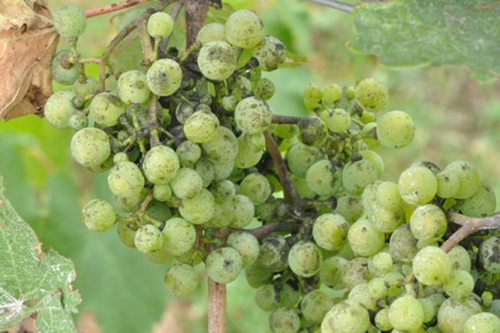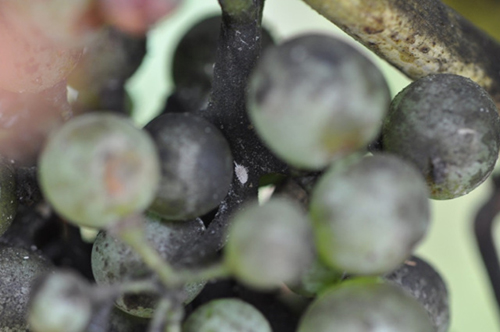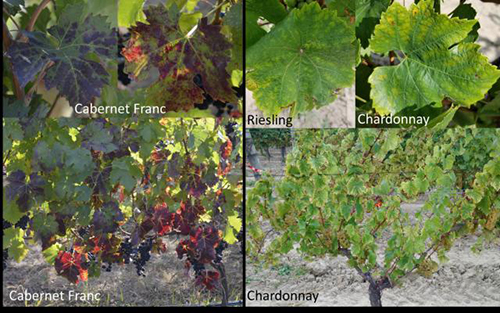Symptoms of diseases caused grapevine leafroll-associated-3 (GLRaV-3) and grapevine red blotch virus (GRBV) have become apparent in infected vines in the past couple weeks.
Grape leafroll disease (GLD) symptoms are more apparent on red vinifera vines than whites and they vary based on variety of factors including environmental conditions, cultivar, age of the vines, stage and severity of (one or more than one virus) infection and viral load etc. It is believed that cool night time temperatures after a long stretch of heat trigger symptom expression in vinifera cultivars. This typically happens in early to mid-August around. Typical symptoms of GLD in red-fruited vinifera cultivars include reddish-purple interveinal discoloration with green strips surrounding the primary veins. In later stages, the margins of symptomatic leaves roll backwards. In white-fruited vinifera cultivars such dramatic symptoms are not seen but some cultivars show yellowing and rolling of leaf margins typically at the end of the growing season. Hybrid varieties may also be infected and not exhibit any foliar symptoms. However, fruit on infected vines, with our without symptoms, usually do not mature as well as that on uninfected vines.

Symptoms associated with grapevine leafroll disease on red-fruited cultivars cv. Merlot (on left) and white-fruited cultivar cv. Chardonnay (on right). (Source: AAFC, SuRDC).
Mealybugs and scale insects that can transmit GLRaV-3 secrete a sugary substance that not only attract ants, but also acts as a food source for sooty mould fungi. The latter are not an issue for wine grapes but can make table grapes unmarketable. While sooty mould has not been shown to affect wine quality, it is a strong indication that there is a large population of mealybugs in the vineyard.

Sooty mould growth on grape berries

Grape mealybugs inside cluster with sooty mould
Grapevine Red Blotch Virus
Although, the symptoms of GLD and Grape Red Blotch Disease are similar, the reddish discoloration on the leaves of GRBD affected red-fruited vinifera cultivars are blotchy and in some cases the primary and lateral veins show purple to reddish discolorations. Symptoms of red blotch on white cultivars are less distinctive. No downward rolling of leaf margins was observed in GRBV infected red and white fruited cultivars.

Red blotch symptoms
Symptoms associated with grapevine red blotch virus on red-fruited wine grape cultivars cv. Cabernet Franc on left and white-fruited cultivars cv. Riesling and Chardonnay on right (Photo: Sudarsana Poojari)
Accurate detection and identification of the causal organism of symptoms is critical. Although, most of red-fruited cultivars show distinct symptoms on mature leaves, infected vines do not show symptoms the first year after they are infected in the vineyard. It is strongly recommended to get it tested by an accredited lab if the planting material is suspected for virus infections. The viruses can detected throughout the growing season. Petioles (the stem of the leaf) or dormant wood can be tested for the presence of virus. If you notice vines with suspicious symptoms, mark the vine trunks with spray paint or flagging tape. Collect samples as shown in the pamphlet below and submit them for testing to confirm which virus, if any, is present. This way, if infected vines are identified, they can be removed during winter pruning. Refer to the link below for information on sampling protocols:
CCOVI-Grapevine-Virus-Testing-brochure
The following labs offer testing for grape viruses:
CCOVI Analytical Services Lab: https://brocku.ca/ccovi/virus-testing/
Pest Diagnostic clinic, University of Guelph: http://afl.uoguelph.ca/plant-health-diagnostics
A and L labs: https://www.alcanada.com/
Norgen: https://norgenbiotek.com/services/plant-viroid-and-virus-detection-services
Source : ONfruit